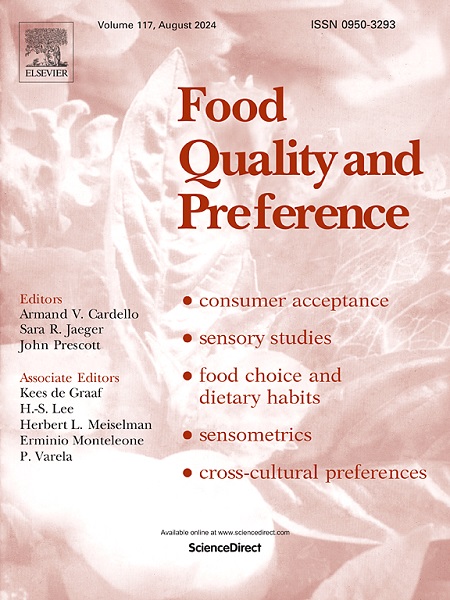Changes in desire for food sensory attributes according to the arousal levels of negative emotions: Focusing on anger and sadness
IF 4.9
1区 农林科学
Q1 FOOD SCIENCE & TECHNOLOGY
引用次数: 0
Abstract
Food choice and intake can be influenced by emotional state, driving cravings for certain sensory attributes. This study aimed to investigate how negative emotions with different arousal levels, such as anger (high arousal) and sadness (low arousal), affect sensory desire and identify how eating behavior types—external, emotional, and restrained eating—moderate these changes. Angry, sad, and neutral (control) states were induced using video stimuli over three weeks, with one-week intervals. These were presented in a randomized, counterbalanced order. Sensory desire was measured before and after emotion induction. Craved foods under each emotional state were listed and their sensory, emotional, and imagery attributes were assessed using a check-all-that-apply (CATA) protocol. Participants' eating behaviors were also assessed using Dutch Eating Behavior Questionnaire. Results (n=114) showed that emotional states, eating behavior types, and their interaction significantly influenced sensory desire, with emotions having the greatest impact. Anger increased cravings for intense flavors and chewing, while sadness increased cravings for rich flavors and soft textures. Associations among sensory, emotional, and imagery attributes were drawn from CATA results. Spicy and stimulating flavors were related to intense imagery and positive emotions with diverse arousal, while creamy and sweet attributes were linked with comforting imagery and positive low-to-middle arousal emotions. Those who exhibited no specific dietary behaviors (n=37) showed changes in a greater number of sensory desires than external eaters (n=40) and emotional/restrained eaters (n=37). These findings provide deeper insights into the psychological factors driving food intake and cravings related to negative emotions and eating behavior types.
根据负面情绪的唤醒水平,对食物感官属性的渴望变化:关注愤怒和悲伤
食物的选择和摄入量会受到情绪状态的影响,驱动对某些感官属性的渴望。本研究旨在探讨不同唤醒水平的负面情绪,如愤怒(高唤醒)和悲伤(低唤醒)是如何影响感官欲望的,并确定进食行为类型(外部进食、情绪进食和克制进食)是如何调节这些变化的。愤怒、悲伤和中性(对照)状态在三周内通过视频刺激诱导,间隔一周。这些以随机、平衡的顺序呈现。在情绪诱导前后分别测量感官欲望。列出每种情绪状态下的渴望食物,并使用检查所有适用(CATA)协议评估其感官,情感和图像属性。参与者的饮食行为也使用荷兰饮食行为问卷进行评估。结果(n=114)表明,情绪状态、饮食行为类型及其相互作用显著影响感官欲望,其中情绪影响最大。愤怒会增加对强烈口味和咀嚼的渴望,而悲伤会增加对浓郁口味和柔软质地的渴望。从CATA结果中得出感官、情感和意象属性之间的关联。辛辣和刺激性的口味与强烈的意象和具有不同唤醒的积极情绪有关,而奶油味和甜味的属性与舒适的意象和积极的中低唤醒情绪有关。那些没有表现出特定饮食行为的人(n=37)比外食者(n=40)和情绪/克制者(n=37)表现出更多的感官欲望变化。这些发现为我们深入了解与负面情绪和饮食行为类型相关的驱动食物摄入和渴望的心理因素提供了更深入的见解。
本文章由计算机程序翻译,如有差异,请以英文原文为准。
求助全文
约1分钟内获得全文
求助全文
来源期刊

Food Quality and Preference
工程技术-食品科技
CiteScore
10.40
自引率
15.10%
发文量
263
审稿时长
38 days
期刊介绍:
Food Quality and Preference is a journal devoted to sensory, consumer and behavioural research in food and non-food products. It publishes original research, critical reviews, and short communications in sensory and consumer science, and sensometrics. In addition, the journal publishes special invited issues on important timely topics and from relevant conferences. These are aimed at bridging the gap between research and application, bringing together authors and readers in consumer and market research, sensory science, sensometrics and sensory evaluation, nutrition and food choice, as well as food research, product development and sensory quality assurance. Submissions to Food Quality and Preference are limited to papers that include some form of human measurement; papers that are limited to physical/chemical measures or the routine application of sensory, consumer or econometric analysis will not be considered unless they specifically make a novel scientific contribution in line with the journal''s coverage as outlined below.
 求助内容:
求助内容: 应助结果提醒方式:
应助结果提醒方式:


